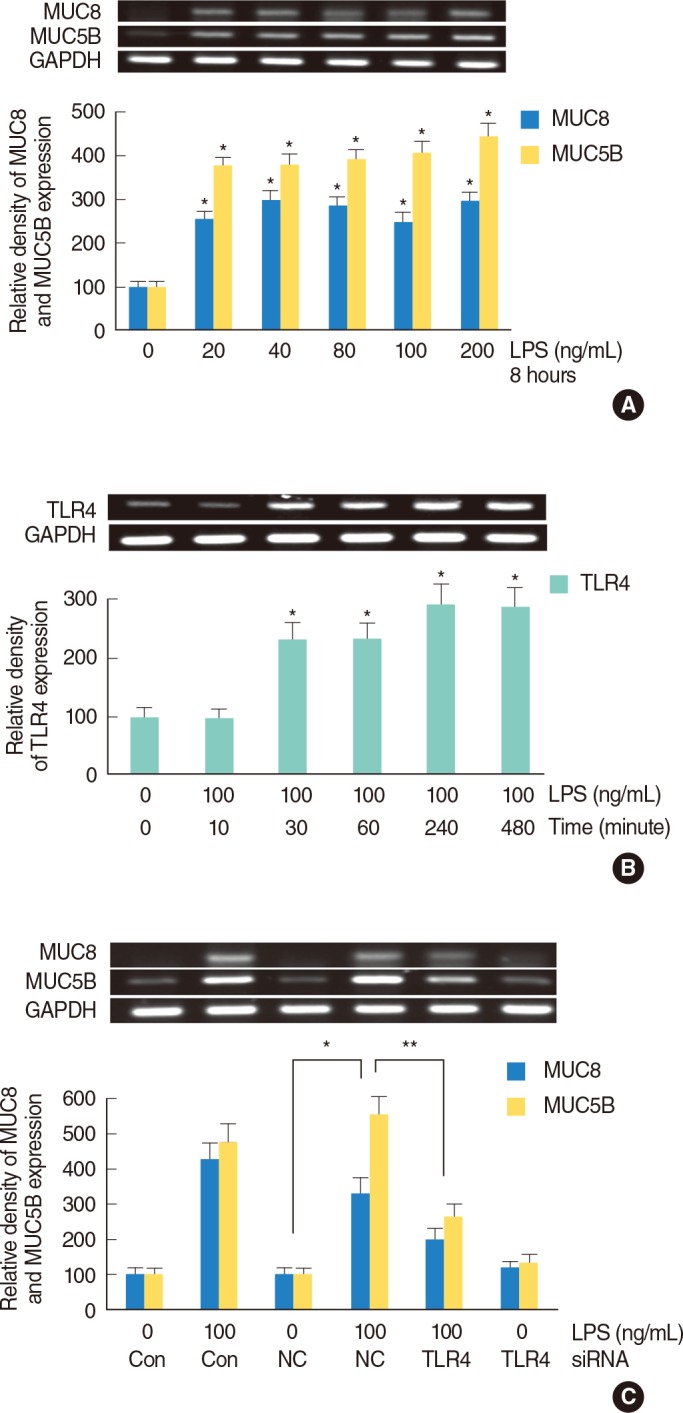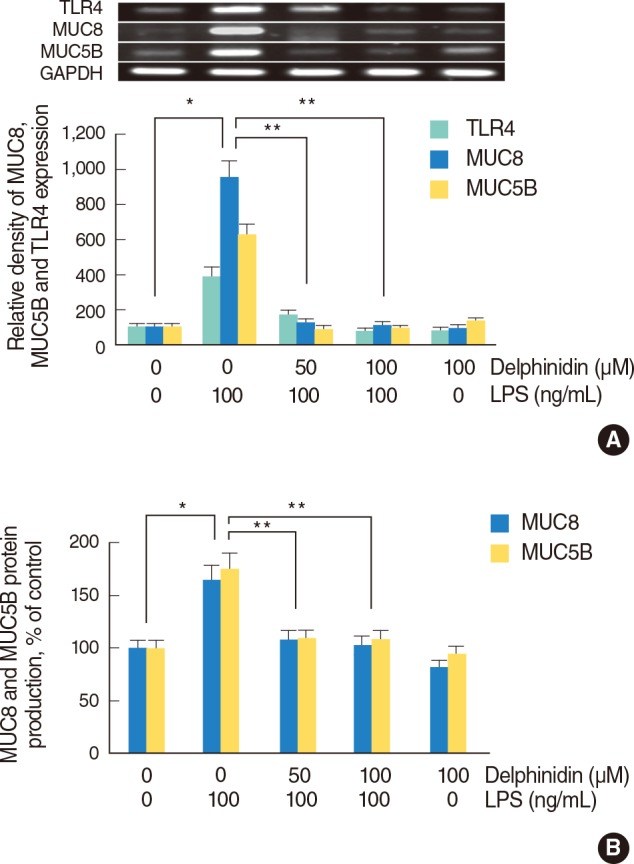INTRODUCTION
MATERIALS AND METHODS
Materials
Cell culture and treatment
RT-PCR analysis of TLR4, MUC8, and MUC5B mRNA expression
Real-time PCR analysis of MUC8 and MU5B mRNA expression
ELISA analysis of MUC5B and MUC8 protein
Western blot analysis of ERK1/2 and p38 MAPK phosphorylation
Cell transfection with small interfering RNA (siRNA) for TLR4
Statistical analysis
RESULTS
LPS-induced TLR4, MUC8, and MUC5B expression in NCI-H292 cells
 | Fig. 1The effects of LPS on MUC8, MUC5B, and TLR4 expression in human NCI-H292 cells. (A) Results of reverse transcriptase-polymerase chain reaction (RT-PCR) showed that MUC8 and MUC5B mRNA expressions were significantly increased by treatment with all dosages of LPS. (B) Results of RT-PCR showed TLR4 mRNA expression was significantly increased by treatment with LPS in a time-dependent manner. (C) Results of RT-PCR showed that LPS-induced MUC8 and MUC5B expressions were significantly attenuated by knockdown of TLR. LPS, lipopolysaccharide; TLR, toll like receptor; Con, control (not treated); NC, negative control (treated with lipofectamine 2000 only). *P<0.05 compared with zero value of LPS. **P<0.05 compared with LPS (100 ng/mL) only. |
The effect of delphinidin on LPS-induced TLR4, MUC8, and MUC5B expression in NCI-H292 cells
 | Fig. 2The effects of delphinidin on LPS-induced TLR4, MUC8, and MUC5B expression in NCI-H292 cells. (A) Results of reverse transcriptase-polymerase chain reaction (RT-PCR) showed that delphindin significantly attenuated LPS-induced TLR4, MUC8 and MUC5B mRNA expression. (B) Results of enzyme-linked immunosorbent assay (ELISA) showed that delphinidin significantly attenuated LPS-induced MUC8 and MUC5B protein production. LPS, lipopolysaccharide; TLR, toll like receptor. *P<0.05 compared with zero value of LPS. **P<0.05 compared with LPS (100 ng/mL) only. |
The effect of delphinidin on LPS-induced phosphorylation of ERK1/2 and p38 MAPK in NCI-H292 cells
 | Fig. 3The effects of delphinidin on LPS-induced phosphorylation of ERK1/2 and p38 MAPK in NCI-H292 cells. (A) Results of Western blot showed that LPS significantly activated the phosphorylation of ERK1/2 and p38 MAPK. (B) Results of Western blot showed that LPS-induced phosphorylation of ERK1/2 and p38 MAPK were significantly blocked by pretreatment with delphinidin for 60 minutes before being incubated with LPS for 60 minutes. ERK1/2, extracellular signal related kinase 1/2; MAPK, mitogen-activated protein kinase; LPS, lipopolysaccharide. *P<0.05 compared with zero value of LPS. **P<0.05 compared with LPS (100 ng/mL) only. |
The effect of delphinidin on LPS-induced TLR4, MUC8 and MUC5B expression in human nasal epithelial cells
 | Fig. 4The effects of delphinidin on LPS-induced TLR4, MUC8, and MUC5B in human nasal epithelial cells. (A) Results of real-time polymerase chain reaction (PCR) showed that MUC8 and MUC5B mRNA expression was significantly increased by treatment of LPS and peaked at 100 ng/mL of LPS. (B) Results of reverse transcriptase-PCR showed that LPS-induced TLR4, MUC8 and MUC5B mRNA expression was significantly attenuated by delphinidin. TLR, toll like receptor; LPS, lipopolysaccharide. *P<0.05 compared with zero value of LPS. **P<0.05 compared with LPS (100 ng/mL) only. |




 PDF
PDF Citation
Citation Print
Print


 XML Download
XML Download